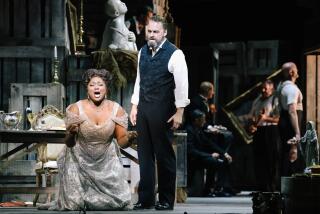Those who brought art to a wider world
- Share via
Because of her numerous TV appearances, Beverly Sills introduced a wide audience to the world of opera. In this popularizing role, however, she was part of a long artistic tradition. Other such popularizers include:
Leopold Stokowski (1882-1977), America’s first star conductor, who spent 25 years building the Philadelphia Orchestra into a world-class organization, then reached millions across the globe when he ascended the podium in Disney’s 1940 movie “Fantasia” to conduct his own orchestration of Bach’s Toccata and Fugue in D minor and other works, and also to shake hands with Mickey Mouse.
Rudolf Nureyev (1938-93), a Russian Kirov Ballet dancer who defected to the West in 1961 and single-handedly shifted the emphasis in ballet onto the male dancer with his brooding magnetism, staggering good looks, fabled technique and legendary partnership with Margot Fonteyn.
Leonard Bernstein (1918-90), a pianist, conductor and composer of serious music (“Chichester Psalms,” “Mass”) and Broadway shows (“West Side Story,” “Candide”) who taught a generation of youthful TV viewers how to appreciate classical music through his “Young People’s Concerts” series.
Laurence Olivier (1907-89), a British Shakespearean actor who became a matinee idol starring as Heathcliff in the 1939 film “Wuthering Heights,” then went on to produce and star in Shakespeare’s “Henry V” (1944) and “Hamlet” (1948) -- for which he won best film and best actor Academy Awards in 1949.
The Three Tenors: Luciano Pavarotti, Placido Domingo, Jose Carreras. Each tenor had a successful independent career, but their teaming for a 1990 concert in Rome on the eve of the World Cup final in Italy -- to raise money for the Carreras Foundation after Carreras’ successful treatment for leukemia -- so dazzled audiences that a string of such concerts followed roughly every four years until 2002. The telecast of the second concert, at Dodger Stadium in 1994, was seen by more than a billion people. Purists decried the phenomenon, but untold numbers of people learned to recognize and thrill to “Nessun Dorma” from Puccini’s “Turandot.”
More to Read
The biggest entertainment stories
Get our big stories about Hollywood, film, television, music, arts, culture and more right in your inbox as soon as they publish.
You may occasionally receive promotional content from the Los Angeles Times.









